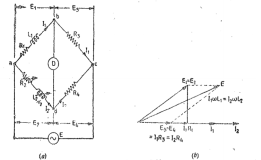|
I1 P = I2 R ---------------------(1) For the galvanometer current to be zero, the following conditions also exist: I1 = I3 = E/P+Q-----------------------------(2) I2 = I4 = E/R+S ---------------------------------(3) Combining the above three equations we get, P/P+Q = R/R+S --------------------------------(4) from which Q.R = P.S ----------------------------------------------------------------(5) R = S*(P/Q) |
|
Vc = R2/(R1+R2) x Vs Vc = 120Ω/ 80Ω + 120 Ω x 100 = 60 volts For the second series arm, ADB VD = R4/(R3+R4) x Vs VD = 160Ω/ 480Ω + 160Ω x 100 = 25 volts The voltage across points C-D is given as: Vout = VC – VD Vout = 60 -25 = 35 volts The value of resistor, R4 required to balance the bridge is given as: R4 = R2R3/R1 = 120Ω x 480Ω/80Ω = 720 Ω |
 P/R =
P/R =  250 x 10 -3 /100 = 0.05A = 50 mA. The maximum allowable voltage which can be applied to the bridge = 2 x 50 x 10 -3 x 100 = 10VVoltage across the series resistor = 20 – 10 = 10V Current through the series resistor = 2 x 50 x 10 -3 x 100 x 10 -3 Resistance of series resistor Rs = 10/100 x 10 -3 = 100ΩQ5) Explain Maxwells bridge?
250 x 10 -3 /100 = 0.05A = 50 mA. The maximum allowable voltage which can be applied to the bridge = 2 x 50 x 10 -3 x 100 = 10VVoltage across the series resistor = 20 – 10 = 10V Current through the series resistor = 2 x 50 x 10 -3 x 100 x 10 -3 Resistance of series resistor Rs = 10/100 x 10 -3 = 100ΩQ5) Explain Maxwells bridge?
|
L1 = R3/R4 L2 R1 = R3/R4 (R2+r2) |
|
At Balance (r1+1/jwC1) (R4/ 1+jwC4R4) = 1/jwC2. R3 ( r1 + 1/jwC1) R4 = R3 / jwC2 (1+jwC4R4) r1R4 – jR4/wC1 = -jR3/wC2 + R3R4C4/ C2 Equating real and imaginary terms we obtain r1 = C4/C5 xR3 And C1 = R4/R3 x C2 Two independent balance equations are obtained if C4 and R4 are chosen as the variable elements Dissipation factor D1 = tan ɸ = w C1 r1 = w . R4/R3 . C2 . C4/C2 . R3 = wC4R4 |



